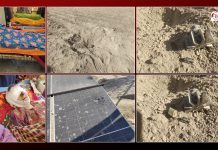Bountiful deposits of lithium and other precious minerals have been discovered in Balochistan’s Mashkel region. The discovery in Hamun-e-Mashkel, a tourist hotspot spanning 5,000 square kilometres, could generate significant foreign exchange and stimulate economic growth.
Dr. Yasir Shaheen Khalil, Assistant Director of the Geological Survey of Pakistan, outlined the promising prospects of Hamun-e-Mashkel in a conversation with Wealth Pak. He indicated that the majority of the area is within the Chaghi district, while a portion of it extends into Washuk. Dr. Khalil said, “It’s a vast area, comparable in size to a large lake. The term ‘Hamun’, Persian for ‘Salt Lake’, is an apt name given the concentrations of minerals found here after water evaporation.”
Dr. Khalil explained that the region’s underground saline water has led to the formation of key minerals such as sodium chloride, potassium chloride, magnesium chloride, lithium, gypsum, and salt. He emphasized the significance of Lithium deposits, which plays a significant role in modern technology, primarily in the manufacture of batteries for electronic devices.
In addition, the Siya Dik mine in the Chaghi district of Balochistan has also caught Dr. Khalil’s attention. The mine, situated between Mashki cha and Durban cha in the water-scarce rural areas of Nokundi tehsil, contains valuable deposits of copper, gold, and molybdenum. Dr. Khalil stated that the Siya Dik mine could potentially become the second-largest porphyry copper prospect.
This mine, over half a century old, was initially explored by the Geological Survey of Pakistan in collaboration with Saindak Metals Limited between 2015 and 2016. “However, the project was later abandoned by a private firm, the Sanjrani Mining Company, and the Metallurgical Corporation of China (MCC),” Dr. Khalil explained. MCC is also involved in the Saindak copper, gold, and silver mine, located 35 kilometers west of Siya Dik.
“Following detailed investigations, including geophysical surveys, drilling, and feasibility studies, a joint venture between SMC and MCC has now resumed exploration,” Dr. Khalil said. “We are moving towards the conversion of the exploration license into a mining license.”
While the lithium discovery could potentially stimulate economic growth and development, it also underscores the challenges faced in managing abundant natural resources. Despite its mineral wealth, Balochistan remains one of the least developed regions , and its inhabitants have frequently raised concerns about the perceived unfair extraction of their region’s resources.




























